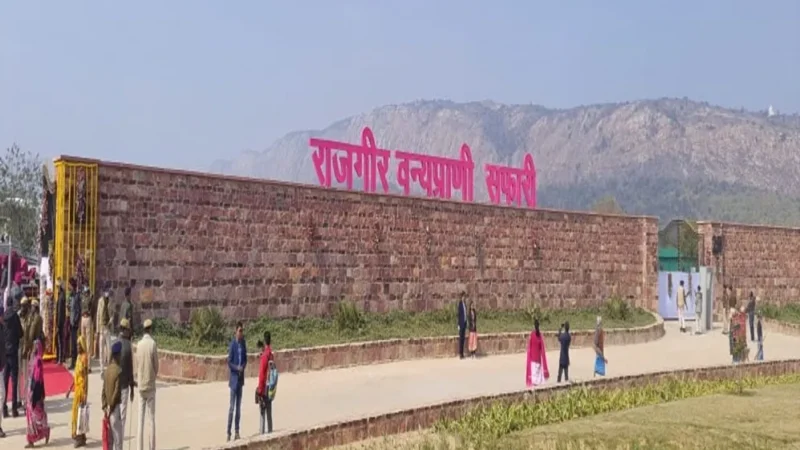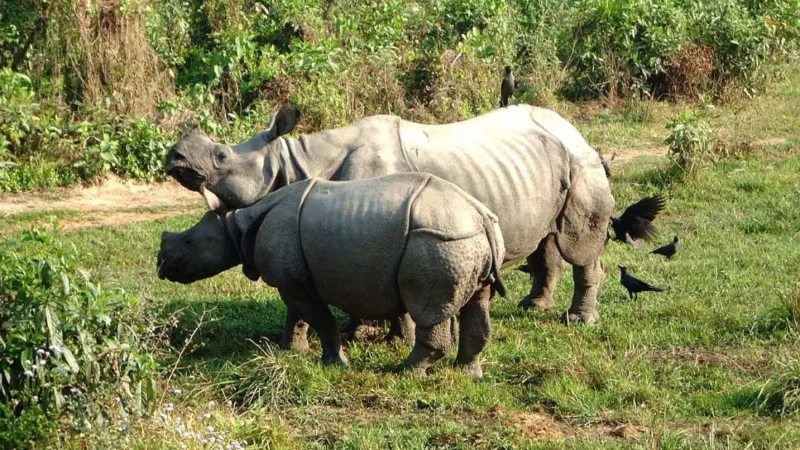Top 14 Wildlife Sanctuary in Bihar

Table of Contents
ToggleBihar Wildlife Sanctuary List -
Welcome to our blog, where we embark on a captivating journey to discover Bihar, India’s rich and diverse wildlife sanctuaries. Nestled amidst the scenic landscapes and lush greenery, these protected areas offer a haven for many flora and fauna, making Bihar an enchanting paradise for nature enthusiasts, wildlife photographers, and eco-tourists.
From the mystical legends of ancient India to the heartwarming tales of conservation efforts, each sanctuary has its unique story to tell. Join us as we delve into the hidden treasures of Bihar’s wildlife sanctuaries, where the symphony of nature echoes through the dense forests and tranquil water bodies.
Unveil the mysteries of the mighty Bengal tigers, watch elegant deer frolic in the meadows, and witness the graceful flight of migratory birds that make these sanctuaries their temporary home. We will traverse the geographical wonders, explore the avian marvels, and delve into the conservation initiatives that have made these sanctuaries a refuge for endangered species.
Whether you are a wildlife enthusiast seeking a glimpse of India’s diverse ecosystem or simply a soul searching for solace amidst the beauty of nature, this blog will surely take you on an unforgettable adventure through Bihar’s untamed wilderness.
So, grab your binoculars, pack your camera, and set out to experience the untamed magic within the Wildlife Sanctuaries of Bihar!
1- Valmiki Wildlife Sanctuary
Valmiki Wildlife Sanctuary is one of the most prominent wildlife sanctuaries in Bihar, India. It is named after the sage Valmiki and is located in the West Champaran district of Bihar, near the border with Nepal. The sanctuary was established to protect the diverse flora and fauna in the region.
Key features of Valmiki Wildlife Sanctuary:
- Location: The sanctuary is situated in the Himalayan foothills and encompasses an area of approximately 900 square kilometers.
- Biodiversity: Valmiki Wildlife Sanctuary is home to various wildlife species, including the Bengal tiger, Indian elephant, leopard, spotted deer, wild boar, langur, and various bird species. It also provides shelter to numerous plant species.
- Conservation Efforts: The sanctuary plays a crucial role in conserving endangered species and preserving the unique ecosystem found in the region.
- Valmiki National Park: Within the sanctuary is a portion known as the Valmiki National Park, a core area where wildlife is given the highest level of protection.
- Safari: The sanctuary offers visitors the opportunity to experience wildlife through safari tours, allowing them to spot some diverse animal species in their natural habitat.
Valmiki Wildlife Sanctuary attracts nature enthusiasts, wildlife photographers, and researchers interested in studying the region’s rich biodiversity. It provides a valuable ecological balance and contributes to the conservation efforts in the state of Bihar.
2- Gautam Buddha Wildlife Sanctuary
Gautam Buddha Wildlife Sanctuary is a significant wildlife sanctuary in the Gaya district of Bihar, India. The sanctuary is named after Gautam Buddha, the spiritual leader and founder of Buddhism, as it includes several areas of historical and religious significance to Buddhism.
Key features of Gautam Buddha Wildlife Sanctuary:
- Location: The sanctuary is in the hilly terrain of the Gaya district, part of the South Bihar plains.
- Flora and Fauna: The sanctuary is known for its diverse flora and fauna. It provides a habitat for various animal species, including deer, wild boars, langurs, and several bird species. Additionally, it is home to different plant species, contributing to the ecological richness of the region.
- Buddhist Sites: Apart from its wildlife, the sanctuary includes several Buddhist pilgrimage sites, such as the famous Mahabodhi Temple in Bodh Gaya, a UNESCO World Heritage Site, and an essential destination for Buddhists worldwide.
- Conservation Efforts: The sanctuary serves as an essential area for conserving the region’s biodiversity and contributes to preserving the natural heritage of Bihar.
- Eco-Tourism: Gautam Buddha Wildlife Sanctuary attracts nature enthusiasts, wildlife photographers, and tourists interested in exploring the unique combination of wildlife and cultural sites.
3- Bhimbandh Wildlife Sanctuary
Bhimbandh Wildlife Sanctuary is another significant wildlife sanctuary located in Bihar, India. It is situated in the Munger district of the state and is named after the mythological figure Bhima from the Indian epic Mahabharata.
Key features of Bhimbandh Wildlife Sanctuary:
- Location: The sanctuary is located in the hilly terrain of the Kharagpur Hills in the Munger district of Bihar.
- Biodiversity: Bhimbandh Wildlife Sanctuary is known for its rich biodiversity and diverse flora and fauna. It provides a habitat for various animal species, including tigers, leopards, deer, wild boars, langurs, and bird species.
- Hot Springs: The sanctuary is famous for its natural hot springs, believed to have medicinal properties. The hot springs attract both tourists and locals seeking therapeutic benefits.
- Conservation Efforts: The sanctuary is crucial in conserving the region’s wildlife and natural resources. It is managed by the Bihar Forest Department to protect its unique ecosystem.
- Eco-Tourism: Bhimbandh Wildlife Sanctuary is a popular destination for eco-tourism and nature lovers. Visitors can explore the sanctuary’s diverse landscapes and enjoy the serene environment.
- Bhimbandh Dam: The sanctuary is home to the Bhimbandh Dam, which further adds to the area’s scenic beauty and serves as a water source for wildlife.
4- Kaimur Wildlife Sanctuary
Kaimur Wildlife Sanctuary is a significant wildlife sanctuary in the Kaimur district of Bihar, India. The sanctuary is known for its diverse flora and fauna and provides a protected habitat for various animal species.
Key features of Kaimur Wildlife Sanctuary:
- Location: The sanctuary is in the Kaimur hills, part of the eastern extension of the Vindhya Range.
- Biodiversity: Kaimur Wildlife Sanctuary is known for its rich biodiversity, including various animal species such as tigers, leopards, deer, wild boars, langurs, and bird species.
- Conservation Efforts: The sanctuary plays a crucial role in conserving the region’s wildlife and contributes to preserving the natural heritage of Bihar.
- Scenic Beauty: Kaimur Wildlife Sanctuary is known for its picturesque landscapes, rolling hills, dense forests, and tranquil environment.
- Eco-Tourism: The sanctuary attracts nature enthusiasts and tourists interested in exploring the region’s wildlife and natural beauty. Visitors can engage in activities like wildlife safaris and nature walks.
- Flora: The sanctuary is home to various plant species, contributing to the ecological richness of the region.
Kaimur Wildlife Sanctuary is an essential area for the conservation of the biodiversity of Bihar. It is managed by the Bihar Forest Department to protect its unique ecosystem.
5- Rajgir Wildlife Sanctuary
Rajgir Wildlife Sanctuary is a notable wildlife sanctuary in the Nalanda district of Bihar, India. The sanctuary is named after the town of Rajgir, which is known for its historical and religious significance.
Key features of Rajgir Wildlife Sanctuary:
- Location: The sanctuary is in the picturesque Rajgir hills, part of the Eastern Ghats mountain range.
- Biodiversity: Rajgir Wildlife Sanctuary is known for its diverse flora and fauna. It provides a habitat for various animal species, including deer, wild boars, langurs, and various bird species.
- Scenic Beauty: The sanctuary offers beautiful landscapes with lush greenery, making it an attractive destination for nature lovers and tourists.
- Buddhist and Historical Sites: Apart from its wildlife, Rajgir is famous for its association with Buddhism and has several historical and religious sites, including the Vishwa Shanti Stupa, Griddhakuta Hill, and Venuvana Vihara.
- Eco-Tourism: Rajgir Wildlife Sanctuary attracts nature enthusiasts and tourists interested in exploring the region’s wildlife and natural beauty. Visitors can engage in activities like nature walks and birdwatching.
- Conservation Efforts: The Bihar Forest Department manages the sanctuary to ensure the protection of its unique ecosystem and contribute to the conservation of the region’s biodiversity.
6- Nakti Dam Wildlife Sanctuary
Nakti Dam Wildlife Sanctuary is a wildlife sanctuary in Jamui district of Bihar, India. This sanctuary is relatively small compared to other wildlife sanctuaries in Bihar, but it still plays a crucial role in conserving the region’s biodiversity.
Key features of Nakti Dam Wildlife Sanctuary:
- Location: The sanctuary is situated around the Nakti Dam reservoir, which serves as a water source for wildlife and nearby communities.
- Biodiversity: Nakti Dam Wildlife Sanctuary is known for its diverse flora and fauna. It provides a habitat for various animal species, including deer, wild boars, langurs, and several bird species.
- Scenic Beauty: The sanctuary offers picturesque landscapes with the Nakti Dam reservoir and the surrounding hilly terrain, making it an attractive destination for nature enthusiasts and tourists.
- Eco-Tourism: Nakti Dam Wildlife Sanctuary attracts visitors interested in exploring the region’s wildlife and enjoying the serene environment.
7- Pant Wildlife Sanctuary
Pant Wildlife Sanctuary is a wildlife sanctuary in the East Champaran district of Bihar, India. The sanctuary is named after India’s first Prime Minister, Pandit Jawaharlal Nehru, also known as Panditji or Chacha Nehru.
Key features of Pant Wildlife Sanctuary:
- Location: The sanctuary is situated in the Terai region of Bihar, near the border with Nepal.
- Biodiversity: Pant Wildlife Sanctuary is known for its diverse flora and fauna. It provides a habitat for various animal species, including deer, wild boars, langurs, and numerous bird species.
- Eco-Tourism: The sanctuary attracts nature enthusiasts and tourists interested in exploring the region’s wildlife and natural beauty.
- Conservation Efforts: The Bihar Forest Department manages the sanctuary to ensure the protection of its unique ecosystem and contribute to the conservation of the region’s biodiversity.
- Terai Region: The Terai region, where the sanctuary is located, is a transition zone between the plains and the foothills of the Himalayas, known for its rich biodiversity.
8- Bhagalpur Wildlife Sanctuary
Bhagalpur Wildlife Sanctuary is a significant wildlife sanctuary in Bhagalpur district of Bihar, India. The sanctuary is known for its diverse flora and fauna and provides a protected habitat for various animal species.
Key features of Bhagalpur Wildlife Sanctuary:
- Location: The sanctuary is situated in the eastern part of Bihar, near Bhagalpur.
- Biodiversity: Bhagalpur Wildlife Sanctuary is known for its rich biodiversity. It provides a habitat for various animal species, including deer, wild boars, langurs, and numerous bird species.
- Conservation Efforts: The Bihar Forest Department manages the sanctuary to ensure the protection of its unique ecosystem and contribute to the conservation of the region’s wildlife.
- Eco-Tourism: Bhagalpur Wildlife Sanctuary attracts nature enthusiasts and tourists interested in exploring the region’s wildlife and natural beauty.
- Gangetic Dolphins: The sanctuary is located along the Ganges River, home to the endangered Gangetic dolphins. The sanctuary plays a role in their conservation efforts.
- Bhagalpur City: The sanctuary is located relatively close to Bhagalpur City, making it accessible for visitors and researchers interested in studying the wildlife and ecology of the region.
9- Vikramshila Gangetic Dolphin Sanctuary
Vikramshila Gangetic Dolphin Sanctuary is an important wildlife sanctuary in Bihar, India. It is specifically established to conserve the endangered Gangetic dolphins in the Ganges River.
Key features of Vikramshila Gangetic Dolphin Sanctuary:
- Location: The sanctuary is situated in the Bhagalpur and Kahalgaon regions along the Ganges River in Bihar.
- Gangetic Dolphins: The sanctuary is home to the Gangetic dolphins, also known as the Ganges River dolphins (Platanista gangetica). These dolphins are unique species of freshwater dolphins and are among the most endangered cetaceans in the world.
- Conservation Efforts: Vikramshila Gangetic Dolphin Sanctuary is dedicated to the conservation and protection of the Gangetic dolphins. The sanctuary is a protected area where measures are taken to safeguard these dolphins from threats such as pollution, habitat degradation, and accidental entanglement in fishing gear.
- Eco-Tourism: The sanctuary attracts tourists and nature enthusiasts interested in witnessing these rare and fascinating creatures in their natural habitat.
- Research: The sanctuary is also an essential site for research and studies related to Gangetic dolphins and the conservation of riverine ecosystems.
The Gangetic dolphins have faced severe population decline due to various human activities, and the sanctuary’s establishment is a crucial step in their conservation and protection. It serves as a valuable area for ecological preservation and contributes to the efforts to safeguard the biodiversity of the Ganges River.
10- Koshi Tappu Wildlife Sanctuary
Koshi Tappu Wildlife Sanctuary is a significant wildlife sanctuary located in the eastern region of Nepal, near the border with Bihar, India. While most of the sanctuary is in Nepal, a small portion extends into Bihar, making it a transboundary conservation area.
Key features of Koshi Tappu Wildlife Sanctuary:
- Location: The sanctuary is situated in the eastern Terai region of Nepal, along the eastern bank of the Koshi River. The Koshi River forms the natural boundary between Nepal and Bihar, India.
- Biodiversity: Koshi Tappu Wildlife Sanctuary is renowned for its diverse range of bird species, especially migratory birds. It is an important wintering and resting ground for various avian species that migrate from the northern regions during the colder months.
- Ramsar Site: The sanctuary has been designated as a Ramsar Wetland of International Importance due to its significance in supporting many waterbirds.
- Wildlife: Apart from birds, the sanctuary is also home to other wildlife species, including wild water buffalo, wild boars, deer species, and several reptiles.
- Conservation Efforts: Koshi Tappu Wildlife Sanctuary is dedicated to conserving and protecting its unique ecosystem, including the diverse birdlife and the habitats of various wildlife species.
- Eco-Tourism: The sanctuary attracts birdwatchers, wildlife enthusiasts, and eco-tourists interested in exploring the region’s rich biodiversity.
11- Kusheshwar Asthan Bird Sanctuary
Kusheshwar Asthan Bird Sanctuary is a significant bird sanctuary in Bihar, India. It is situated in the Kusheshwar Asthan block of the Darbhanga district.
Key features of Kusheshwar Asthan Bird Sanctuary:
- Location: The sanctuary is in the floodplains of the river Koshi, a major river in Bihar.
- Biodiversity: Kusheshwar Asthan Bird Sanctuary is known for its rich avian diversity and is an important habitat for migratory birds during winter. Various species of resident and migratory birds can be spotted here.
- Conservation Efforts: The sanctuary is dedicated to conserving and protecting its unique avian ecosystem and wetland habitats.
- Eco-Tourism: Kusheshwar Asthan Bird Sanctuary attracts birdwatchers, nature enthusiasts, and eco-tourists interested in observing and studying the region’s diverse birdlife.
- Koshi Barrage: The nearby Koshi Barrage, a structure built across the river Koshi for water management, also contributes to the sanctuary’s ecological significance.
The sanctuary provides a valuable site for bird conservation and contributes to the overall biodiversity of Bihar. Visitors can enjoy birdwatching and appreciate the serene environment in this bird-rich sanctuary.
12- Kanwar Jheel Bird Sanctuary
Kanwar Jheel Bird Sanctuary is a significant bird sanctuary in Bihar, India. It is situated in the Begusarai district of the state.
Key features of Kanwar Jheel Bird Sanctuary:
- Location: The sanctuary is around the Kanwar Jheel lake, a large freshwater lake known for its importance as a wetland and bird habitat.
- Biodiversity: Kanwar Jheel Bird Sanctuary is known for its rich avian diversity and is an essential habitat for various resident and migratory bird species. During winter, many migratory birds flock to the sanctuary, making it a birdwatcher’s paradise.
- Conservation Efforts: The sanctuary is dedicated to conserving and protecting its unique avian ecosystem and wetland habitats.
- Eco-Tourism: Kanwar Jheel Bird Sanctuary attracts birdwatchers, nature enthusiasts, and eco-tourists interested in observing and studying the region’s diverse birdlife.
- Wetland Importance: The sanctuary is significant as it contributes to conserving wetlands, which are crucial ecosystems supporting a wide range of wildlife and providing ecological services.
Visitors to Kanwar Jheel Bird Sanctuary can enjoy the serene environment and witness the various bird species that call the sanctuary their home.
13- Baralia Jheel
Baralia Jheel is a significant wetland or lake located in Bihar, India. It is known for its ecological importance as a bird habitat and wetland ecosystem.
Key features of Baralia Jheel:
- Location: Baralia Jheel is situated in the Begusarai district of Bihar.
- Biodiversity: The wetland is an important habitat for various resident and migratory bird species. During winter, many migratory birds flock to the lake, making it a birdwatcher’s paradise.
- Wetland Importance: Baralia Jheel is significant as it contributes to the conservation of wetlands, which are crucial ecosystems supporting a wide range of wildlife and providing ecological services.
- Eco-Tourism: The lake attracts birdwatchers, nature enthusiasts, and eco-tourists interested in observing and studying the region’s diverse birdlife and wetland ecosystem.
Baralia Jheel is a natural treasure for Bihar and is vital in supporting the region’s avian biodiversity and wetland conservation.
14- Kusheshwar Asthan Bird Sanctuary
Kusheshwar Asthan Bird Sanctuary is a significant bird sanctuary located in the Kusheshwar Asthan block of the Darbhanga district in Bihar, India.
Key features of Kusheshwar Asthan Bird Sanctuary:
- Location: The sanctuary is in the floodplains of the river Koshi, a major river in Bihar.
- Biodiversity: Kusheshwar Asthan Bird Sanctuary is known for its rich avian diversity and is an important habitat for migratory birds during winter. Various species of resident and migratory birds can be spotted here.
- Conservation Efforts: The sanctuary is dedicated to conserving and protecting its unique avian ecosystem and wetland habitats.
- Eco-Tourism: Kusheshwar Asthan Bird Sanctuary attracts birdwatchers, nature enthusiasts, and eco-tourists interested in observing and studying the region’s diverse birdlife.
- Koshi Barrage: The nearby Koshi Barrage, a structure built across the river Koshi for water management, also contributes to the sanctuary’s ecological significance.
The sanctuary provides a valuable site for bird conservation and contributes to the overall biodiversity of Bihar. Visitors can enjoy birdwatching and appreciate the serene environment in this bird-rich sanctuary.





